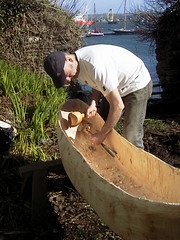- Invite participation of all stakeholders
- Legislative context
- Establish scope of issues to be addressed in EIA
- Identify issues which have been addressed elsewhere
- Identify consultations required
- Overview of proposed scheme, with impacts on water qulity, ecology, ornithology, sedimentary regime, fisheries, navigation, heritage, recreation, noise, air quality, geology, traffic, socio-economics
Case Study
Falmouth harbour Commissioners have started a project to dredge a channel within Falmouth Harbour to allow access to the falmouth Cruise Terminal of large cruise ships.
Scoping and EIA will cost £410,000. At time of writing the contract for the full EIA is under tender. The scoping was undertaken by Royal Haskoning - a good overview of the EIA process can be found on page 57.
It has been estimated that 250,000 cubic metres of soil will have to be dredged. the spoil is likely to be heavily contaminated by centuries of mining/shipping waste product.
Appropriate legislation; EIA Directive (for a local governement perspective see), Coast Protection Act 1949, Conservation Regulations 1994 and, for a bit of a shock...
The Conservation Regulations transposed the EU's Habitats Directive. Understanding these Regualtions is key, since the Cruise Terminal is within the Fal/Helford SAC. Note that Natural England provide a mapping service here
Cutting the crap, there are two big issues: what will the effect be of the inevitable release of toxic wastes into the water column, and where will those wastes go? Dunno, and a variety of places.
If approved, the work will start after the transposition of the Environmental Liability Directive. The Directive simply obliges operators to pay for pollution and remediation costs. So if the dredging all goes tits up resulting in the destruction of habitats/fisheries, will the operators be liable? Er, no, actually. Under the ELD it is a defence if the works were carried out under permit.
Consents: CPA49 s.34 requires consent from the Secretary of State for Transport; FEPA85 requires consents for marine works and dredging from MCEU.
At the end of the process, after the EIA has been written, an Environmental Statement will be prepared. This is a formal report that documents the findings of the EIA process, and is to accompany consents applications.
Note; CEFAS have produced a good Guidance Note for EIA for offshore wind farms insofar as FEPA and CPA concerned, see

